The Central Dogma Theory 3: RNA, transcription and the genetic codes
Hello readers and welcome to another episode in the central dogma series. In central dogma theory 1, we discussed how the DNA occupies the central portion in the transfer of genetic information within the biological system and in central dogma theory 2, we discussed one of the distinguishing abilities of DNA that makes it to be at the central portion of the dogma, that is, the ability to make copies of itself - replication.
As a quick reminder, there are three biomolecules involved in the transfer of genetic information within the biological system - the DNA, the RNA and the protein. The RNA is transcribed from DNA templates in a process known as transcription while protein is synthesized from RNA in a process known as translation.
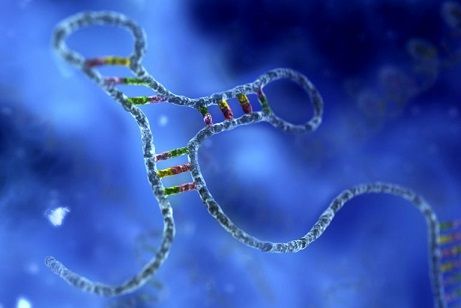
The RNA
The RNA is an abbreviation for ribonucleic acid and just like DNA, it is made up of monomers called nucleotides. Aside from this, they also share some other similar characteristics which include;
- same pentose sugar content,
- same nitrogenous base contents in form of adenine, guanine and cytosine,
- same phosphate group content, sometimes referred to as phosphoric acid; and finally
- both have base pairing content of guanine and cytosine.
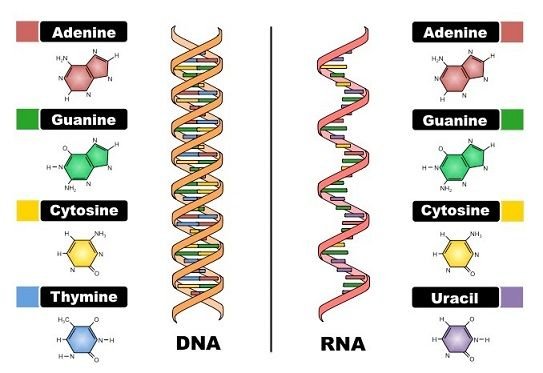
However, DNA and RNA are quite different chemically and structurally in a lot of ways. We can vividly recall that the DNA is a double stranded molecule of which the two strands twist around each other in a form of helix. In a complete contrast, the RNA happens to be a single stranded nucleic acid. In addition, while DNA and RNA contain nitrogenous bases, the thymine in DNA is replaced with uracil in RNA. Also, the pentose sugar in DNA is a deoxyribose sugar while that of RNA is a ribose sugar. Lastly, there are three types of RNA in living organisms depending on their functions, there is only one kind of DNA in nature.
What are the different types of RNA that exist?
Three different types of RNA exist in the cells of living living organisms namely; the messenger RNA (mRNA), the transfer RNA(tRNA) and the ribosomal RNA (rRNA). In addition, some special type of RNAs occur as regulatory molecules with the ability to inhibit the expression of certain genes by halting translations within the cell. They work by binding to a particular location on the messenger RNA and hinders it from being translated. These special types of RNA have also been implicated in some types of cancers and mutation in living organisms.
The mRNA is the molecule that is directly synthesized from DNA in the process known as transcription. It is synthesized in the nucleus of cells and then transported to the cytoplasm where it is coded and translated into protein in conjunction with the two other RNAs. It is responsible for conveying genetic information from the DNA, encoding it and translating it into proteins.
The transfer RNA (tRNA) is a special type of RNA that plays a critical function role in the translation during protein synthesis. It translate the genetic codes in form of triplet codes in the mRNA into specific amino acids during protein synthesis. The amino acids are joined by polypeptide bond to form protein. The shape of tRNA is in form of clover leaf containing three loops. One of the loops act as an amino acid attachment site while another one act as the anticodon site. The anticodon site binds to the codon area on mRNA.
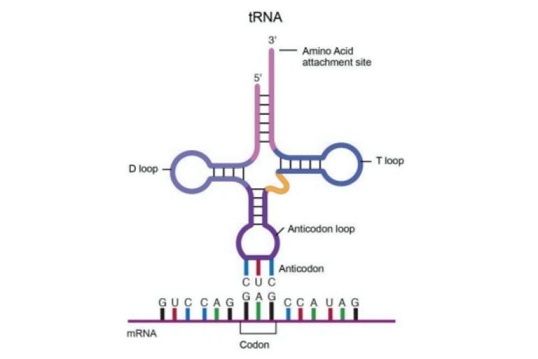
The ribosomal RNA is a type of RNA that constitute one of the components of the cell organelle known as the ribosome. Ribosomes of living cells are made up large and small subunits of which both consist of ribosomal proteins and rRNA. The ribosome contain a binding location for mRNA and two for tRNA. The small ribosomal subunit attaches itself to mRNA molecule during translation while the a special type of tRNA known as initiator tRNA molecule binds to a specific codon on the same mRNA after which the large ribosomal subunit joins to form a translation complex.
The transcription process
The transcription process is the method by which a copy of mRNA is formed from DNA strand. During this process, the information in the DNA is encoded into the mRNA. The process is catalyzed by an enzyme known as the RNA polymerase and a group of proteins called transcription factors. Both the transcription factors and the RNA polymerase combine to form the transcription initiation complex. The formation of the complex triggers the transcription process which allows the RNA polymerase to begin mRNA synthesis by assembling complementary bases of the parental DNA strand. The base sequence in the mRNA continues elongation until the strand becomes completely synthesized after which transcription is terminated and the mRNA is transported into the cytoplasm for translation.
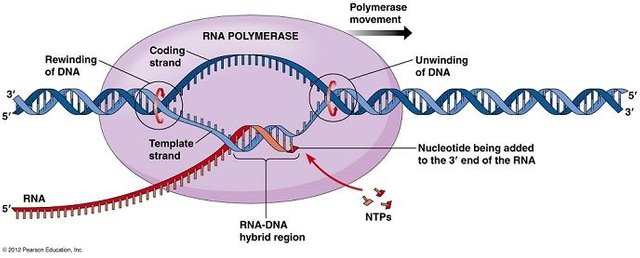
The genetic codes
The genetic code is a language in which genetic information from DNA are encrypted and later translated into a form of proteins. It is a set of rule linking groups of nucleotides in an mRNA molecule to amino acids in a protein. The cells in living organisms decode mRNAs by reading their nucleotides in groups of three, called codons. Simply defined, the codon is a sequence of three nitrogenous bases that codes for an amino acids. There are four bases in nature coding for 20 amino acids. The four bases can be arranged in sequence of threes in 64 ways. This means that each amino acid can be coded for by more than one codon. Consequently, the genetic codes are said to be degenerates. Three "stop" codons mark the end of a protein while one "start" codon, AUG, marks the beginning of a protein and also encodes the amino acid methionine.
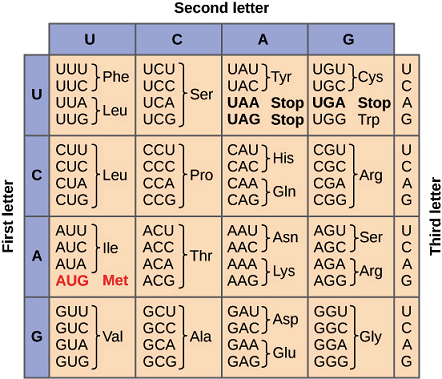
Summary
The RNA is an intermediate molecule in the central dogma theory which is synthesized from a DNA strand and serves as a precursor in the synthesis of proteins. They store information from DNA and translate it to proteins. There are three types namely; mRNA, tRNA and rRNA. The mRNA is synthesized through transcription and it stores the genetic codes in form of codons. The genetic codes are universal and codes for specific amino acids during translation process.
Till my next post, please do feel free to comment and make constructive criticism. Do not forget to upvote as well.
Thanks to everyone that have been supportive in one way or the other. Special thanks to the steemstem management.
References
enotes.com
bioninja.com
nature.com
thoughtco.com
britannica.com
khanacademy.org
sciencedaily.com
Congratulations @hadji, this post is the most rewarded post (based on pending payouts) in the last 12 hours written by a Dust account holder (accounts that hold between 0 and 0.01 Mega Vests). The total number of posts by Dust account holders during this period was 7626 and the total pending payments to posts in this category was $1829.21. To see the full list of highest paid posts across all accounts categories, click here.
If you do not wish to receive these messages in future, please reply stop to this comment.
Comprehensive short and accurate...
This is a great one
Congratulations @hadji!
Your post was mentioned in the hit parade in the following category:
Great post there, keep up good work !
This replay was created using STEEMER.NET Alpha ( support STEEMER.NET Transactor / Wallet / Exchange Project here: https://steemit.com/investors-group/@cryptomonitor/steemer-net-steem-blockchain-transactor-for-windows-android-app-funding-update-243-1200-sbd-28-12-2017 )
I am a silly robot!
Hmm.. @cheetah you need a nap.
!cheetah bad robot
:)
Lol
In my latest post (pls see it) I indicated an abuse going on here (I mentioned you on the post) and I want you to see it and take action. I wish you more success.
Hi @patrice .. how can I talk about @mack-bot with you ? I have shared video links and your bot downvoting me !
even downvoting other my regular posts .
video link sharing is not spamming . is it ?
very wrong cheetah
lolwut, unique comment